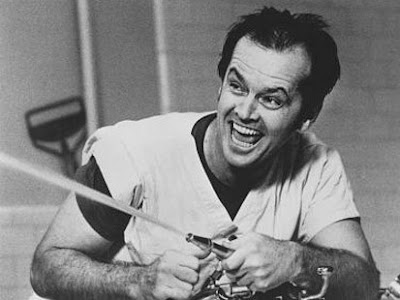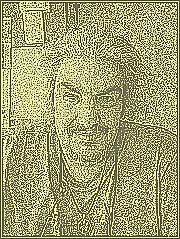ABC News runs debate on newer electroshock, quotes MindFreedom
ABC News web site ran a "pro and con" piece about so-called "new" electroshock using supposedly brief pulse electricity to induce a convulsion. Several movement activists and MindFreedom members, including director David Oaks, are quoted. You can comment on the ABC web site.
ABC used an image from the film "One Flew Over the Cuckoo's Nest" for their story, a frequent graphic used in mainstream media stories on shock. Actually, the film minimized the long-term hazards of even the older-style electroshock.
ABC News
20 July 2007
A link to the original ABC News web site article is here:
http://abcnews.go.com/Technology/story?id=3397685&page=1
Electroshock Therapy Gets a Makeover
Despite Changes, ECT Still Stirs Controversy
By SIBILE MORENCY
Amy, a New York resident, had her first electroshock treatment at the age of 72 & and despite the stigma that electroshock is a brutal, outdated procedure for treating psychiatric health, she said it's been a miracle for her.
And it's probably more common than most people believe.
"I started 10 years ago when I was very depressed. I was diagnosed as bipolar. I took medicine -- Prozac, a whole slew of them -- but they didn't help," she said. "Then a psychiatrist told one of my friends that I should have ECT. My friends told me to get ECT. It was the only solution, I couldn't go on the way I was. After ECT, everyone told me it was a miracle."
Amy, who asked that her last name not be used, is now 82 and continues to receive electroshock therapy regularly.
Although she admits that after each procedure she has a headache and her memory is temporarily "a little bit off," she insists that ECT has been a success for her.
"I know there's a lot of negative. I think it's a rather painless procedure. It's wonderful," she said. "If medicine doesn't work, then yes, I would recommend it to someone else."
The New Face of ECT
Since its terrifying depiction in the movie "One Flew Over the Cuckoo's Nest," electroshock, or electroconvulsive therapy (ECT) has changed dramatically. According to doctors who use it, the administration of the anesthetic, changes in the type of electricity used and the way seizures are triggered have transformed the procedure, making it safer and more effective.
The latest clinically available form of ECT, called ultrabrief pulse unilateral, uses a briefer stimulus that lasts for .25 to .3 milliseconds, according to Dr. Sarah Lisanby at the New York State Psychiatric Institute. The difference in the type of electricity used allows doctors to induce seizures with lower amounts of electricity then was previously possible.
"It does away with lifelong memory loss," said Dr. Harold Sackheim, a leading proponent of ECT and chief of the department of biological psychiatry at the New York State Psychiatric Institute. "If there is any memory loss, it's markedly reduced."
ECT Not Uncommon
Although there are no national reporting requirements for the number of procedures performed, experts estimate that approximately 100,000 patients a year in the United States and several million worldwide receive ECT. According to Dr. Mustafa Husain, the director of the Geriatric Psychiatry Training Program at the University of Texas Southwestern Medical Center, the newer version of ECT is becoming the standard in practice, particularly at academic medical centers and clinics due to its relatively low amount of adverse effects on the brain.
"We started the new ECT almost a year ago. All of our equipment is now ultrabrief pulse," he said.
Critics Call ECT Russian Roulette
Despite support from many well-respected physicians, ECT is still controversial. Critics view the procedure as a dangerous game of Russian roulette that should be banned.
"You hear from people who succeed. You don't hear from people who lost wedding or childbirth memories," said David Oaks, director of MindFreeedom, a nonprofit organization focused on human rights campaigns in mental health.
Dr. Peter Breggin, founder of the International Center for the Study of Psychiatry and Psychology, is a staunch opponent of the practice.
"If you were in your kitchen, touched your stove and got a convulsion, you would be in the hospital. It would be treated as an emergency. You might even be given anti-seizure medication to ensure that you do not get another convulsion," Breggin said. "Psychiatry is the only place where you damage the brain and call it a cure."
Because unilateral ECT is a shock to the nondominant, nonverbal side of the brain, controls a person's intuition, creativity and emotions, Breggin said patients may have a harder time explaining the side effects they might experience.
"So people when damaged on the nonverbal side can't tell you about it. It's a ruse," Breggin insisted. "Ultrabrief pulse unilateral is still damaging the brain, but it's less obvious. It cures by creating a delirium in which the patient is incapable of normal human emotion."
John Breeding, an Austin, Texas, psychologist, is alarmed by the state of the industry.
"The shock industry is the Enron of mental health. If they're honest, and you ask them, 'How does shock work,' they'll say they don't really know," Breeding said.
Oaks agreed.
"They look at a problem as physical -- drug, drug, drug, drug, drug -- then they'll try shock. The system is so oriented toward this medical model approach. Relapse rate is enormous, so what's their answer? Maintenance shock," he said. "What has happened in the industry is that research has discounted people's memories."
ECT experts recognize the controversial history of the procedure and acknowledge the stigma attached to it.
"The stigma affects providers and patients. The treatment is perceived by the public as brutal," Sackheim said. "Undoubtedly people don't receive the treatment, because they're afraid of it. In some cases it's quite tragic because they may not live."
ECT proponents hope that the newer form of ECT will encourage more people to seek the procedure to cure their depression.
"Finding ways to make ECT safer, beneficial, lowers barriers to accessing the efficacy of this procedure," said Dr. Lisanby.
Still Searching for a Cure
Doctors who use ECT are the first to admit that the complete cure for severe depression still eludes them.
"ECT can be rapidly effective in treating [depression] but always needs maintenance treatment to maintain effects," Lisanby said.
Don Weitz, co-founder of the Coalition Against Psychiatric Assault, a group that opposes the use of ECT, said that the American public is in the dark about its use as a treatment.
"Most people think it no longer exists. When I meet people in the street, they say, 'You're kidding!' And it's increasingly for elderly women," Weitz said. "Two-thirds of people who get ECT are women. This is not a treatment. It always causes brain damage and it targets women."
ABC News
~~~~~~~~
To comment on this article on the ABC News web site go to the bottom of the article and click on "Read Comments and Post Your Own":
http://abcnews.go.com/Technology/story?id=3397685&page=1
David Oaks has already published a comment:
~~~~~~~~
COMMENT by David Oaks published on ABC News web site:
I appreciate that the ABC journalist Sibile Morency included both sides of the debate about shock, which the American Medical Association called one of the most controversial in mental health. Too often I've seen mainstream media primarily emphasize shock industry sources. Thank you Sibile for including the voice of an activist, psychiatrist, psychologist and electroshock survivor who disagree with the procedure.
That said, I would appreciate a human rights focus. It's easy for us all to disagree about what care we seek for ourselves. But I hope we all agree on three key human rights points when it comes to electroshock.
First, full informed consent is crucial; however, all informed consent material we've seen for electroshock is flawed. A British study found that shock researchers tend to unfairly discount subjective reports of memory problems after shock, and this may be one reason why informed consent is fraudulent.
Second, what about alternatives? Domination by the medical model is a problem. The drug, drug, drug, drug, drug, drug, drug, shock approach chokes out a huge range of proven alternatives for people who are even in extreme and overwhelming despair. Many of our members have reached full long-term recovery, even following multiple unsuccessful suicide attempts, with a variety of more humane, more sustainable, less harmful approaches. Why aren't more non-drug and non-shock alternatives offered? The industry maintains its authority by sticking primariily to one model, a medical model.
Finally, what about forced electroshock? We told Ms. Morency about heart breaking cases of involuntary electtroshock over the expressed wishes of the subject. Surely we can all agree that giving such an intrusive and potentially irreversible procedure over a citizen's objections violates core values, For more info see our web site www.mindfreedom.org, or e-mail me at oaks@mindfreedom.org. Speak out!
Sincerely, David W. Oaks, Director, MindFreedom International






No comments:
Post a Comment